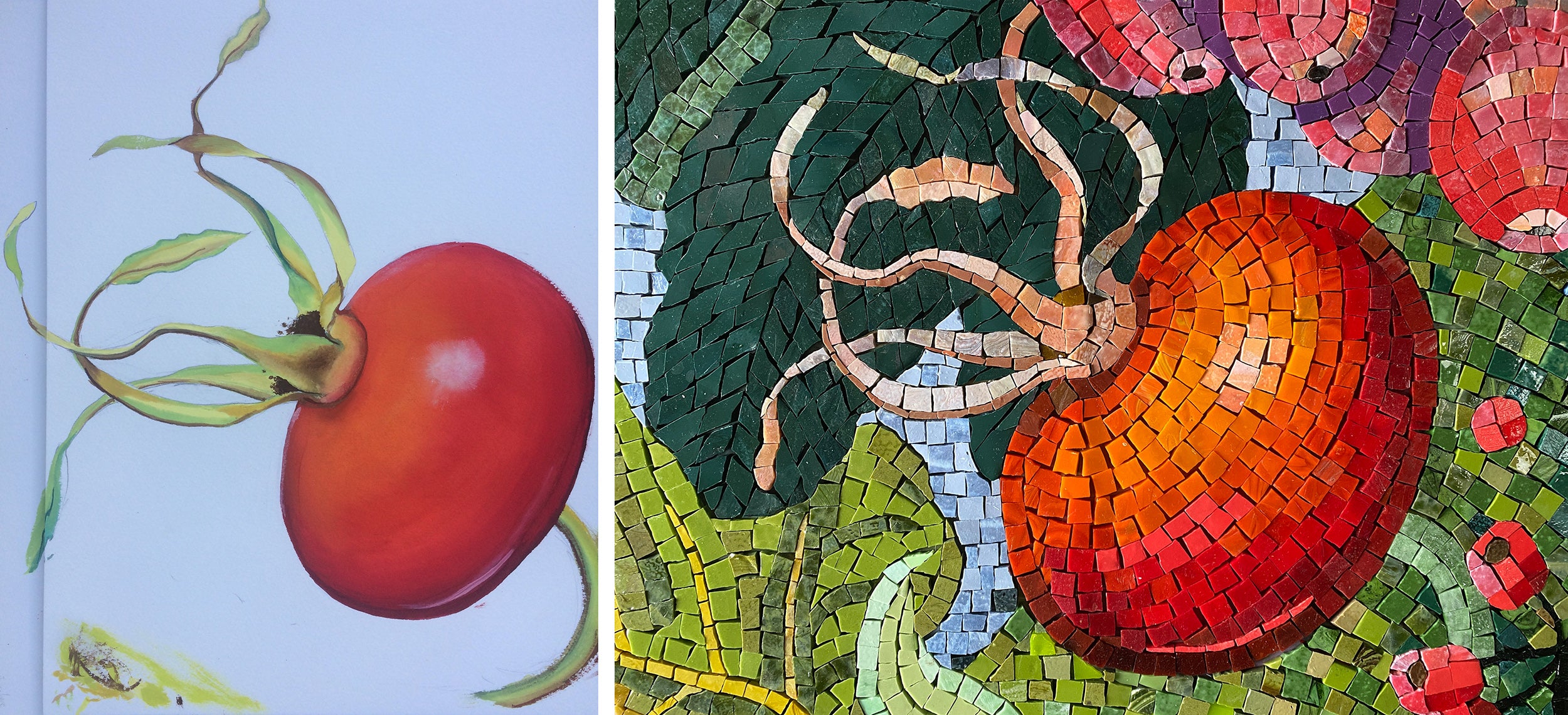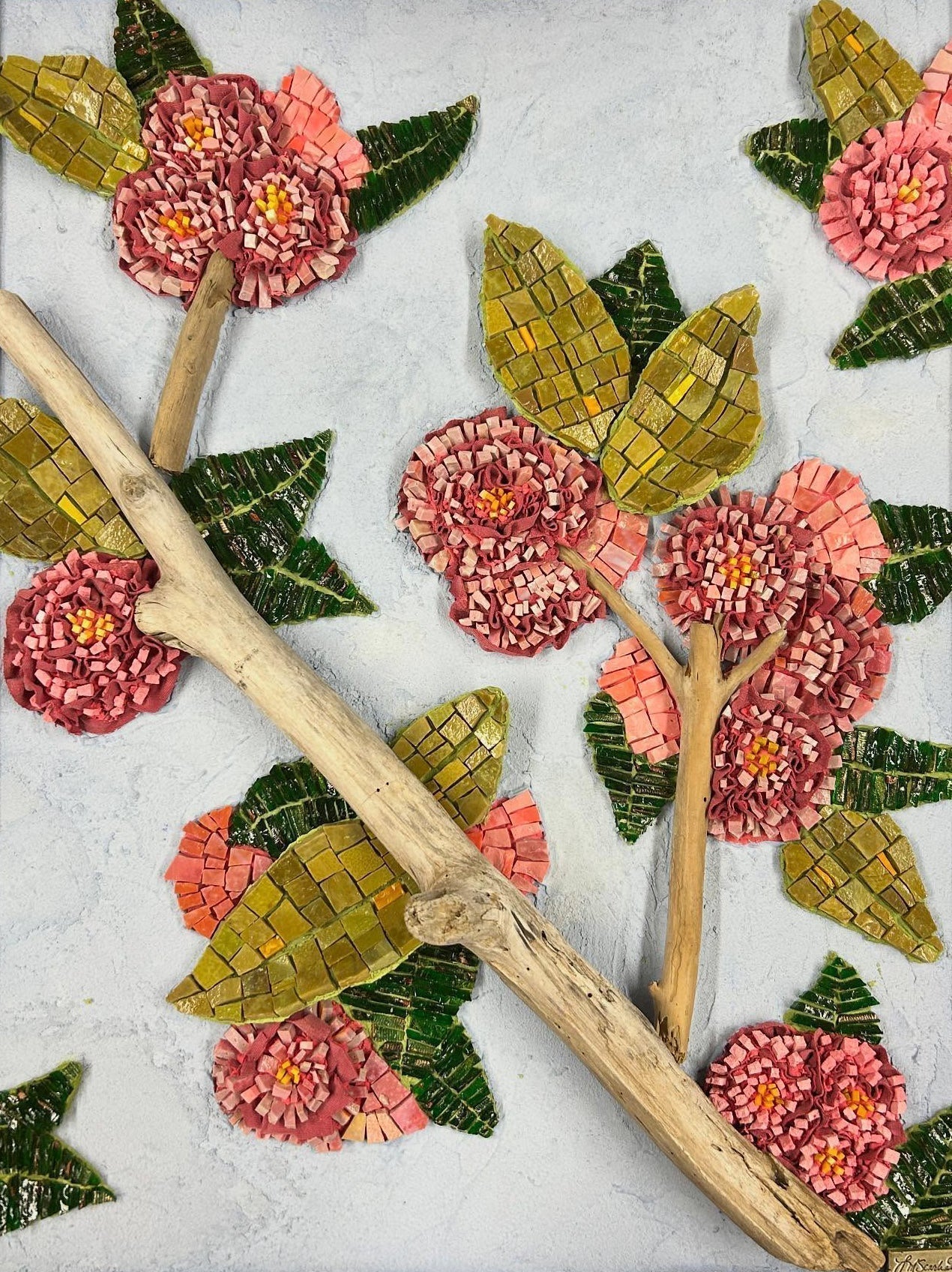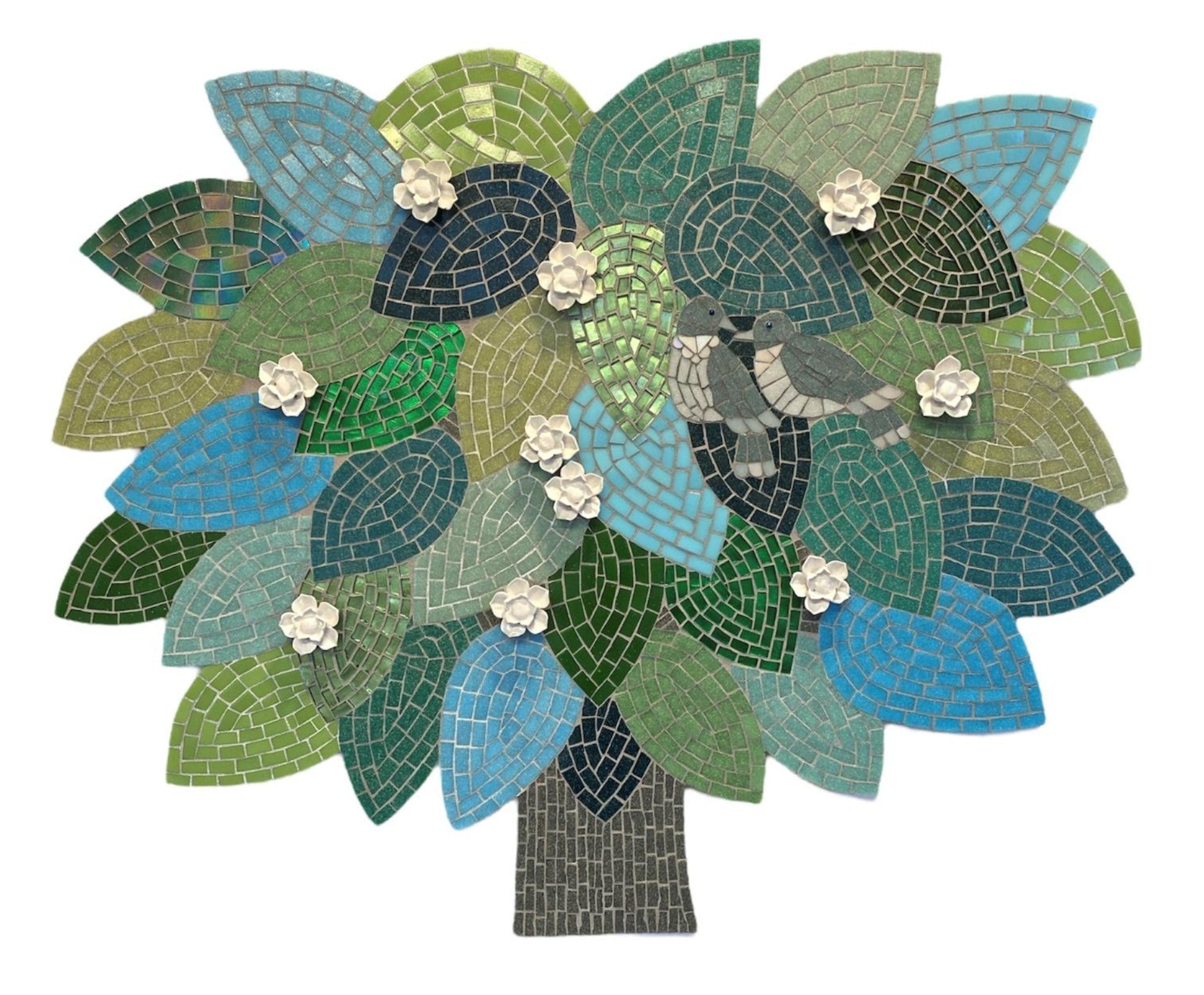
Name: Alison Mac Cormaic
Town (or area) & State/Country you reside in: County Galway, Ireland
Business Name: Alison Mac Cormaic Mosaics
Tell us a little about your artistic background:
I’m one of those people that has tried loads of different art forms, from sewing to stained glass. I really like to know how things are made, and also to understand the nature, or essence, of the art medium. Once I’ve figured it out and completed a few projects I’m ready to move onto the next one!
Do you have any professional art training?
I studied Architectural Glass (stained glass) at Edinburgh College of Art in Scotland way back in the 1990s. I am from Scotland but now live in Ireland. In more recent times I completed a Teaching Certificate, plus a Masters in Design History and Materials Culture in the National College of Art and Design (NCAD) in Dublin, Ireland. This was a fantastic course, investigating how we humans interact with the vast array of stuff in our everyday world.
How did you get started in mosaics?
When I was at Edinburgh College of Art I found some Italian smalti at the back of a cupboard. As I didn’t have any snips or hammer and hardie, all I could do was place them in straight rows, so it wasn’t very satisfying or successful. From then on I took an interest in looking at mosaics and loved figuring out how the pieces were layed down and the images built up.
How long have you been creating mosaic, art, etc?
In the mid 1990s in Ireland I worked in a stained glass studio. I kept all the left over scraps of opaque glass, and laboriously cut them into 1 cm squared pieces. I made a few mosaics to commission and taught mosaic classes at that time. I discovered Wincklemans in the boxes of scrap tiles bought for the classes, and in 2000 I made a shop sign for a local pharmacy which thankfully still looks good today.
I then had a big gap away from doing mosaic and other art, as I was bringing up my family and going back to college, although I did work intermittently as an illustrator. In 2017 I began to apply for County Council and Arts Council Awards, for educational arts projects. In 2019 I was completing a commission which included some signage. A friend who I knew since the 90s (when I was last working with mosaic) suggested making mosaic signs instead. I then began to research different materials online, found Mexican smalti, and decided it was the new medium for me. In addition to the mosaic work, I teach art part time to early school leavers and visit schools to talk to children about built heritage, on a scheme run by the Heritage Council here in Ireland. Life is a bit busy at the moment, I am very, very happy to finally be working as an artist, but sometimes I don’t know how I’m going to squash everything in!

Detail from Lohan’s Pharmacy Shop sign, 2000
Did you start with mosaic or did you work in other mediums before working in mosaic?
I worked with stained glass first. Glass is one of the great loves of my life, especially when it’s handmade. There is something stunning about the intensity of colour, the transitions from light to dark and the unexpected elements left behind by the manufacturing process. In addition, sometimes there are particular colours that are just so unusual and interesting, you can’t get another medium that beats it for excitement. I always loved transparent glass, and never thought that opaque glass would give me the same lift, until I discovered Mexican smalti that is!
What about mosaics resonates with you?
I’m a real traditionalist, I usually follow the Roman rules around using the square as a working unit. I don’t mind if I venture a little away from the principles, but I certainly use them as my first stop. The good thing about Mexican smalti is that the squares are wildly different sizes so although I generally work in organised rows, it never ends up too regular or static.

Woman walking, 2021
What is your favorite part of the mosaic process?
I love putting colour combinations together and I can get pretty carried away finding shades and tones that are just right. The downside is if you run out of the very colour you really need it can be devasting. A sort of mesmerizing search goes on to look for the exact piece. Mexican smalti offers up many choices but finding them can sometimes be a very slow process.

Detail, Entanglement, 2021
Do you have a favorite subject matter? What is it?
If I look over my work I’m generally inspired by nature, pattern and the figure. I also like drawing still life, flowers and single objects. With mosaic I generally submit proposals to open calls, so the subject matter is usually suggested in some way by the brief. I’d really like to try mosaic portraiture, I’m hoping to find a bit of time for that this year.
Where do you find inspiration for subject matter?
My mosaic imagery is usually developed from drawings from life. Although it’s not always possible, for me it’s much easier to capture the true character of an idea, object or person if I draw it in real life.

Detail of work in progress, St Patrick’s Shrine, 2022
Do you have favorite materials you like to work with? What are they?
Mexican Smalti is by far my favourite mosaic material, I love it’s subtle colour changes and differences between the top face and bottom face. It lends itself really well to painterly work. Working with it is a bit like searching for the most beautiful pebbles on a beach. Sometimes I fall in love with one tiny piece of glass and could keep looking at it forever, no wonder making mosaic is so slow.
What is your favorite thing you have created and why?
I usually like the piece I am working on at the time the most, and when it’s done all my energy and thoughts move swiftly on to the next one.

Cassiopeia, Fragment
This work, in response th the theme of Constellations, was inspired by 19th century engravings of the constellation Cassiopeia. As only one side of the sky can be shown at once, parts of the illustrated figures sometimes become cropped. This suggests found fragments of ancient Roman and Greek mosaics, where elements which once made up the whole are now lost. We wonder what form the missing sections may have taken.
Cassiopeia sits with her feet hanging down and the pattern in the border shows a rotating chair. In Greek mythology, Cassiopeia claimed she, and her daughter Andromeda, were more beautiful than the daughters of the sea gods. This angered Poseidon who tied her to a chair and sent her to turn forever in the heavens.
What would you like to learn/add to your mosaics experience?
I would like to make some larger pieces, and perhaps move into abstract and pattern work because I think it sits well within architectural settings.
I’ve recently made my first three dimensional poly-sculpted piece. Working in a sculptural way is new to me and I have really enjoyed it. There is a lot more thinking to be done about the shape, and its place in the final space. I don’t want to just put two dimensional images onto a shape, as I feel that the surface of the sculpture must also enhance its three dimensional aspect. These are the things I’m figuring out at the minute.
What do you find to be the most challenging aspect of mosaics?
Getting to grips with all the different construction processes can be a challenge. Deciding which adhesives and grout to use, or figuring out whether to work direct, or onto mesh, or jacko board can all be a bit of a head wreck.
What is your least favorite thing about mosaics and why?
It takes forever, but I think we’ve all experienced this one!
Tell us a little about your studio
We live in the country, and I’m very lucky that I have a well insulated studio which I call simply, ‘the shed’. It’s just out the back door and quick step over the patio, it has a lovely view of the fields falling away at the back of the house. It has a blue painted wooden floor, plenty of storage and good heating in the winter. This summer I’m hoping to give it a bit of revamp by, replacing the windows and knocking down an internal wall which will double its size.

Studio shot with current project on the go
Do you listen to music while creating (what type/bands)or do you prefer the TV(what shows/genera/channel)? Silence? Pod cast? Etc.?
I like listening to news stations on the radio, or music. I tend to pick one artist and listen to the same album over again for the whole day, but only when I’m on my own that is!
If you could give readers one single piece of advice, what would it be?
Keep sketchbooks
Tell us about your single greatest mosaic moment:
I really liked my first big commission, “Flowers, Fruits and Seedcases. It was made as part of a Per Cent for Art project, where 1% of the building cost of schools and other public building projects is put towards an artwork. My mosaic represents the ten year anniversary of Merlin Woods School in Galway by illustrating the leaves and flowers, fruits or seedheads of ten native woodland species. From the left to the right the plants represent the natural cycle from spring to winter.
 Flowers, Fruits and Seedcases, Merlin Woods School, Galway, 2021
Flowers, Fruits and Seedcases, Merlin Woods School, Galway, 2021

Details, with research drawings of Flowers, Fruits and Seedcases

Details, with research drawings of Flowers, Fruits and Seedcases
Attach 3 of your favorite mosaics by someone else…Why do they capture your interest?

Dixie Friend Gay, Detail from Enduring Monument, 2021
That’s easy, when I decided to work in mosaic again, I spent many a night looking at everything the internet had to say about it. I discovered the artwork of Dixie Friend Gay and I couldn’t believe that something so beautiful could be made from mosaic. Her work is spectacular. From the tiniest element to the grandest scaled-up images there is so much to look at.
https://www.dixiefriendgay.com/

Still image from Carol Bowen You Tube Channel, Nick Cave’s ‘Soundsuits’, 2021
I really enjoy looking at Carol Bowen’s You Tube channel on New York’s the subway mosaics. For example, Nick Cave’s ‘Soundsuits’, or the white, stark lettering by Ann Hamilton and Mayer of Munich at the World Trade Centre. We don’t have any mosaic projects of comparable scale in Ireland. I’m not sure if I’ll ever make it over to America to see them in person but browsing them on the internet is definitely the second best thing.
https://www.youtube.com/channel/UCNuctyNxRtIKVJHVPK8lGTQ

Photo of Lawrence Payne’s Roman Mosaic Workshop kit
I also like the work of Lawrence Payne from Roman Mosaic Workshop. He has a contagious enthusiasm for the promotion of roman mosaic and its design principles. I would have been aware of the general concept of these ‘rules’ but he explains them so simply and clearly. He discusses and demonstrates not only the how but the why of positioning the pieces in certain ways. Each placement of tesserae makes perfect, logical sense when he’s explaining it.
www.romanmosaicworkshops.com
Do you have a favorite color palette?
While there are colours that I love - blue, and others that I really don’t like – maroon ( it was the colour of my school uniform), when
designing work I never think of a colour as a single entity. As you can never see a colour without it being affected by its neighbours, for me it is all about the combination. Even colours that I don’t find individually appealing have their place within different colour ranges. It’s all about putting them together in a way that sings. I do however have some go to favourite combinations, for example, pink and green, or purple and orange.
Who are your top 3 favorite artists or top 3 most influential artists in your work?
When I think of the art that I like best, it is generally the artists whose work I’ve seen in real life that come to mind. For example, I can remember being blown away by a Paul Cezanne painting of a great pine tree in an exhibition I saw at the National Gallery in Edinburgh, Scotland as a teenager.

Paul Cezanne, The Great Pine, 1889
The same happened with David Hockney’s English hedgerows series, I was very lucky to catch the exhibition when in holiday at the Guggenheim, in Bilbao, in 2012.
I also love paintings of interiors that are full of pattern, for example, works by Edouard Vuillard. I could look at them for hours.

Edouard Vuillard, The Dress with Foliage, 1891
In terms of figurative painters, I really admire the Scottish painter Joan Eardley, especially when her figures are abstracted and merge into pattern. I’m a bit of a sucker for good drawing and painting skills.

Joan Eardley, The Children, 1963
Tell us about your next project/s
I am currently working on a Sculpture called ‘St Patrick’s Bell Shrine’. It records 60 years of winners of Glór na nGael, an Irish language organisation that promotes the use of Irish. St Patrick’s Bell Shrine is a jewel encrusted, 12th century relic in the National Gallery which I used as inspiration. Glór na nGael’s logo uses a symbol of three birds, the imagery is taken from stories connected to the life of St Patrick, where the singing of the birds drew him back to Ireland. I have incorporated three birds into the sculpture.
I’m delighted to have been selected for two further awards, which will keep me busy well into 2023. One is the Arts Council’s, Young People, Children and Education (YPCE) award. For this, I will be working as an artist in residence with Children and Adolescent Mental Health Services (CAHMS) in Galway, plus designing and making a mosaic for them. I was also recently selected by Roscommon County Council to create a mosaic commemorating the 100 year anniversary of the burning by the Black and Tans of a village called Knockcroghery near Athlone in Ireland. I am currently at the design stage of these projects and looking forward to shaping them up.

detail of St Patrick's Bell Shrine

detail of St Patrick's Bell Shrine





